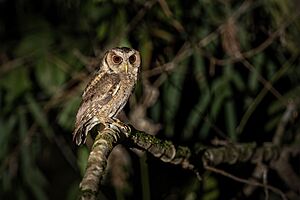Collared scops owl facts for kids
Quick facts for kids Collared scops owl |
|
|---|---|
 |
|
| Conservation status | |
| Scientific classification | |
| Genus: |
Otus
|
| Species: |
lettia
|
The collared scops owl (Otus lettia) is a small owl that lives in parts of Asia. It is found in countries like northern Pakistan, northern India, Nepal, Bangladesh, the Himalayas east to southern China, and Taiwan. Some of these owls travel to warmer places like India, Sri Lanka, and Malaysia during winter. This owl is part of a big group called "typical owls."
Contents
About the Collared Scops Owl
The collared scops owl is a type of owl. It belongs to a large family of owls called Strigidae, which includes most owl species. Another group of owls is the barn owls, called Tytonidae.
Where Do They Live?
These owls are common in forests and other areas with many trees. They make their nests inside holes in trees. A mother owl usually lays 3 to 5 eggs.
What Do They Look Like?
The collared scops owl is a small bird, about 23 to 25 centimeters tall. Even though it is small, it is the largest of the scops owls. Like other scops owls, it has small tufts of feathers on its head that look like ears.
The feathers on its upper body can be grey or brown. This depends on the specific type, or subspecies, of the owl. It often has light, creamy spots. Its underside is a creamy color with thin, darker stripes.
The owl's face is whitish or creamy, and its eyes are orange or brown. It also has a creamy band of feathers around its neck. Male and female owls look very similar. When they fly, their flight path goes up and down a lot.
What Do They Eat?
This owl is active mostly at night. You can often find it during the day because smaller birds will gather around it and make noise while it rests in a tree. The collared scops owl mainly eats insects. Its call is a quiet sound that sounds like goog gook.
Similar Owls
The collared scops owl is mostly found in northern India. In the southern parts of its range, you might find the very similar oriental scops owl (Otus sunia). It also looks a lot like the slightly smaller Indian scops owl. The easiest way to tell these similar owls apart is by listening to their calls. Sometimes, the collared scops owl is even considered a type of Indian scops owl.
Gallery




